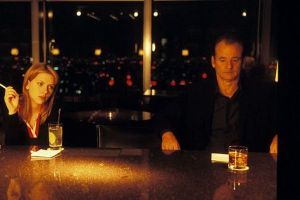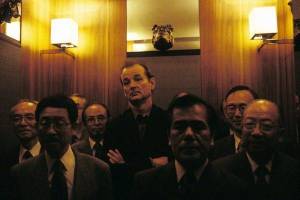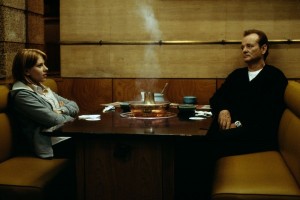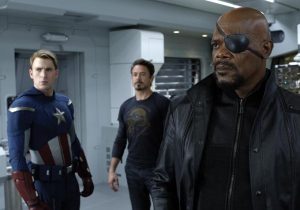Originally Posted July 6th, 2010
On reflection, Lost in Translation has about as short a plot description as you can manage for a 100-minute movie. Guy goes to Japan, guy meets girl, guy and girl explore Tokyo, guy leaves. There's not much all that much to the plot, but that's not to say that nothing happens. Director Sophia Coppola seems content to let her film meander about, almost purposelessly, but it’s a wandering experience built on characters and locations with entrancing magnetism.

Bill Murray plays Bob Harris, an aging movie star whose career and marriage are passed their prime. The latest stop on his star's descent is a commercial shoot in Japan, an embarrassment perhaps only known to him, as every handler, hotel worker or fan that enters his orbit still glad-hands him like his best years happened only yesterday. His wife sends him carpet swatches halfway around the world to make sure his study has the right shade of burgundy. Bob accepts his life with a sarcasm that’s sadder than it is biting, telling jokes to an audience that doesn’t speak his language. The salad days are behind him and it seems he’s all laughed out. So in essence, Bob is Bill Murray, which is a good thing, because Bill Murray is really great at playing Bill Murray.
Most performances are based on the actor disappearing into the part, but here, Murray’s performance is all the more affecting because you feel like you’re watching him as opposed to a character. Barflies and passers-by approach him and gush over how much they love his work. He sees his faced plastered across skyscrapers and vehicles. The viewer has to wonder how many times such things have happened to Murray in real life, and how it must feel to be constantly reminded of your public persona. Even the names of the actor and character are suspiciously similar. As Harris, Murray brings the kind of honesty and vulnerability that make it obvious why Coppola wouldn’t have made the film without him.

Murray’s counterpart is Charlotte (Johansson), a young philosophy graduate dealing with an equally lifeless marriage. She jokes about Bob’s midlife crisis even though she’s hit hers a few decades too early. Charlotte is part of a generation of creatives who are given the world on a platter, but can’t seem to find their place in it. She’s self-critical as a writer, and wryly observes that being a photographer is just a phase all girls go through, “like horses”. There are numerous shots of Charlotte staring out of her hotel window at the Tokyo cityscape, looking for something, even if she's not sure what that something is yet.
Self-discovery in a foreign land is an enticing little fantasy. The idea of breaking out of one's established culture by absorbing the best parts of another is what kept Eat, Pray, Love on bestseller lists for three years. Coppola recognizes and attacks such an impractical solution to personal identity with both humour and frankness. The idea of fast-food cultural consumption is best satirized via an oblivious young starlet played by Ana Faris, who incorporates aspects of Japanese culture into her identity with seemingly little understanding of what they actually mean. When Charlotte admits to feeling nothing after watching a Japanese ceremony, foreign religion being the sort of fashionable thing sightseers pick up like a fake accent, it becomes clear that the setting of the film is merely incidental; this is a film about connecting with people, not places.

With so much of the actual developments happening internally, the real action in Lost in Translation plays out in the repartee between Bob and Charlotte, which starts with the usual complaints about American-Japanese culture clash. Bob cracks jokes about Japan’s food and language while Charlotte seems to be the only person capable of talking to Bob Harris the person instead of Bob Harris the movie star. Coppola writes maybe one or two too many of these “ain’t Japan weird” scenes, but they reinforce the alienation of the characters and how much of a relief one another’s company is. Their conversations gradually become less sweetly sardonic and more personal the longer the two are together . In the film’s most pivotal scene, the pair lay in bed side by side as Charlotte confesses to being stuck in life, with Bob giving advice as best he can. Coppola is content to just let camera hang over them as Charlotte stares up at the hotel ceiling, which doesn't seem so bland and empty when you're sharing it with the right person.
It’s easy to see where the film’s setup could lead, but thankfully, Coppola knows exactly what her movie is about. Her characters have emotional problems and they need an emotional respite, not a physical one. Whatever amount of sexual tension there is for the viewer to decide, Charlotte’s looks serving mostly as a contrast to Bob’s, her baby blues opposite his pale, weary eyes. Their age difference is largely inconsequential, save for some ribbing at Bob’s expense, and in place of a May-December romance, we get a friendship between two people at the same place in different seasons of their lives.

The other real star of Lost in Translation is Japan, which is a constant marvel to watch. The muted tones of the hotel seem a paradox when housed in the otherwise vibrant downtown of Tokyo. When Bob first enters the city, there’s a childlike fascination in his face as he stares out at a city that’s half New York, half circus. As the leads share drinks in a bar early on, the bright lights of the Shinjuku ward broadcast the sleepless activity just outside. The frenetic neon sprawl of the city is juxtaposed with a trip to Kyoto which is almost otherworldly in its tranquility. There’s a regimented pace to each set piece, almost as if the camera is acting as a tour guide, pinpointing all the major highlights. Japan is captured with such loving detail that it’s hard to think about the film being set anywhere else, despite the story's freeform nature.
Coppola’s film has no great dramatic twist, and instead just focuses on how two very sad people make each other’s lives a little more bearable. Yet there’s a cruel aftertaste to every laugh shared between Bob and Charlotte, because it’s known from the beginning that this is a relationship that isn’t meant to last. When the two finally do say goodbye, it’s a moment of almost unparalleled bittersweetness. For a film to make you feel anything by the end is an achievement, but Lost in Translation manages to stir your emotions on two fronts, leaving you heartbroken at the sight of such a beautiful friendship ending, but also joyful, because you got to experience it.
5 out of 5
Directed by Sophia Coppola
2003, USA






